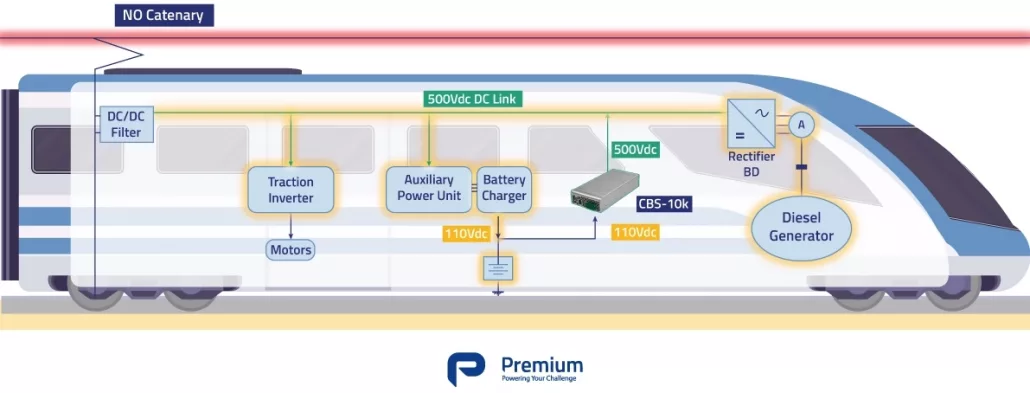Hybrid trains: A must-have converter to start up the diesel generator
In this new article, we want to introduce how our newest DC/DC converter CBS-10K works with a “Start-up diesel engine” application in the hybrid trains. The CBS-10K has been designed under rolling stock standards and is the perfect complement to start the diesel engine in diesel-electric hybrid trains.
How does a hybrid train work?
Aiming for an environment-friendly transportation system railway infrastructures have been upgraded in recent years for trains to contaminate less. The electric traction offers the environmental advantage of substantially reducing CO2 emissions, as well as reducing noise in large cities.
Major companies in the railway industry have been committed to incorporating greener trains. As a result, there has been notable growth in hybrid technology, where trains combine diesel and electric motors.
Hybrid trains are connected in series, so the electric motor is responsible for powering the train’s wheels. The diesel combustion engine is responsible for powering the batteries and the electric motor, as a power generator.
Trains with hybrid engines can be installed on both electrified and non-electrified tracks (or a combination of the two), as they can use one of the two engines, depending on what is available. For example, if the batteries run out while running on a non-electrified track, the train can always switch to relying entirely on the diesel engine.
Where catenaries are electrified, energy regeneration during braking may not be allowed, which means not only having to run in diesel mode but also hybrid mode. The use of batteries also allows the catenary voltage to be reduced, as during peak energy demand (accelerations) the battery will take care of the operation.
What is the application of the CBS-10K converter in hybrid trains?
The CBS-10K DC/DC converter enables train shunting at low speed when power is not available from the catenary, by supplying the rectifier to work as an inverter when starting the engine. This “Diesel Engine Starting System” is mostly found in hybrid trains, being able to power the train’s engines from the catenary or, using a diesel generator, to power the traction inverter.
How does the converter work in the hybrid train?
The device can be installed inside the train to transform the battery voltage (110Vdc) to a higher voltage direct current (DC) bus (500Vdc). The train in catenary operation supplies power to all systems through the DC/DC converter (1500/500Vdc).

If there is a catenary failure, the CBS-10K DC/DC converter will use the battery voltage to feed the bidirectional rectifier through the 500Vdc bus, which will act as an inverter, feeding the alternator (engine in this case) so that the diesel generator starts.

Once the generator is started, it switches to “diesel mode”, where the generator feeds the engines through the alternator and the traction inverter, passing through the rectifier.

In addition to this application, the CBS-10K DC/DC converter is also capable of moving the train in the depot from the train’s batteries at ultra-slow speed to perform maintenance operations.

In these two applications, our device takes on a high degree of importance as it is an essential system to start the diesel generator and operate at maximum efficiency.
With an average power output of 6kW, this series of DC/DC converters allows a parallel connection, thus increasing the power output. All models offer a 500Vdc output and have been developed with SiC technology, which gives them a high-power density.
The most remarkable feature is its single output, offering a maximum peak power of up to 10kW for 40 seconds.





